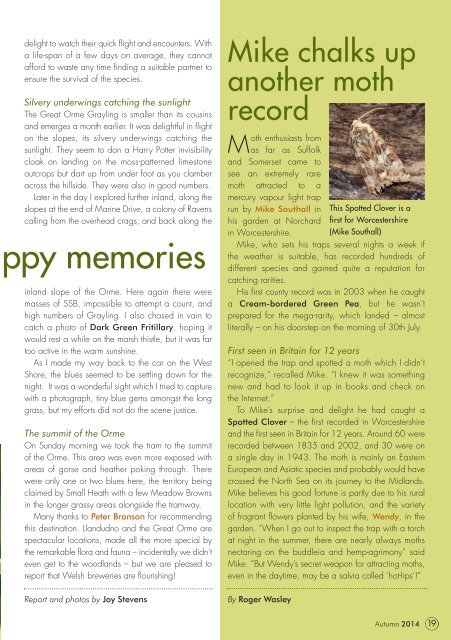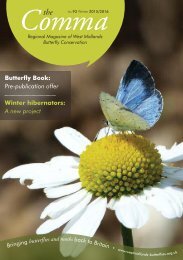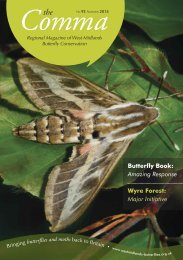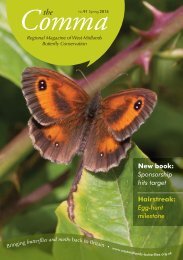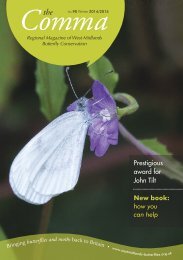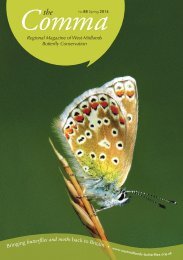Comma-WestMidBC-autumn-2014
Butterfly Magazine for the West Midlands Branch of Butterfly Conservation
Butterfly Magazine for the West Midlands Branch of Butterfly Conservation
Create successful ePaper yourself
Turn your PDF publications into a flip-book with our unique Google optimized e-Paper software.
delight to watch their quick flight and encounters. With<br />
a life-span of a few days on average, they cannot<br />
afford to waste any time finding a suitable partner to<br />
ensure the survival of the species.<br />
Silvery underwings catching the sunlight<br />
The Great Orme Grayling is smaller than its cousins<br />
and emerges a month earlier. It was delightful in flight<br />
on the slopes, its silvery underwings catching the<br />
sunlight. They seem to don a Harry Potter invisibility<br />
cloak on landing on the moss-patterned limestone<br />
outcrops but dart up from under foot as you clamber<br />
across the hillside. They were also in good numbers.<br />
Later in the day I explored further inland, along the<br />
slopes at the end of Marine Drive, a colony of Ravens<br />
calling from the overhead crags, and back along the<br />
ppy memories<br />
inland slope of the Orme. Here again there were<br />
masses of SSB, impossible to attempt a count, and<br />
high numbers of Grayling. I also chased in vain to<br />
catch a photo of Dark Green Fritillary, hoping it<br />
would rest a while on the marsh thistle, but it was far<br />
too active in the warm sunshine.<br />
As I made my way back to the car on the West<br />
Shore, the blues seemed to be settling down for the<br />
night. It was a wonderful sight which I tried to capture<br />
with a photograph, tiny blue gems amongst the long<br />
grass, but my efforts did not do the scene justice.<br />
The summit of the Orme<br />
On Sunday morning we took the tram to the summit<br />
of the Orme. This area was even more exposed with<br />
areas of gorse and heather poking through. There<br />
were only one or two blues here, the territory being<br />
claimed by Small Heath with a few Meadow Browns<br />
in the longer grassy areas alongside the tramway.<br />
Many thanks to Peter Branson for recommending<br />
this destination. Llandudno and the Great Orme are<br />
spectacular locations, made all the more special by<br />
the remarkable flora and fauna – incidentally we didn’t<br />
even get to the woodlands – but we are pleased to<br />
report that Welsh breweries are flourishing!<br />
Report and photos by Joy Stevens<br />
Mike chalks up<br />
another moth<br />
record<br />
Moth enthusiasts from<br />
as far as Suffolk<br />
and Somerset came to<br />
see an extremely rare<br />
moth attracted to a<br />
mercury vapour light trap<br />
run by Mike Southall in This Spotted Clover is a<br />
his garden at Norchard first for Worcestershire<br />
in Worcestershire. (Mike Southall)<br />
Mike, who sets his traps several nights a week if<br />
the weather is suitable, has recorded hundreds of<br />
different species and gained quite a reputation for<br />
catching rarities.<br />
His first county record was in 2003 when he caught<br />
a Cream-bordered Green Pea, but he wasn’t<br />
prepared for the mega-rarity, which landed – almost<br />
literally – on his doorstep on the morning of 30th July.<br />
First seen in Britain for 12 years<br />
“I opened the trap and spotted a moth which I didn’t<br />
recognize,” recalled Mike. “I knew it was something<br />
new and had to look it up in books and check on<br />
the Internet.”<br />
To Mike’s surprise and delight he had caught a<br />
Spotted Clover – the first recorded in Worcestershire<br />
and the first seen in Britain for 12 years. Around 60 were<br />
recorded between 1835 and 2002, and 30 were on<br />
a single day in 1943. The moth is mainly an Eastern<br />
European and Asiatic species and probably would have<br />
crossed the North Sea on its journey to the Midlands.<br />
Mike believes his good fortune is partly due to his rural<br />
location with very little light pollution, and the variety<br />
of fragrant flowers planted by his wife, Wendy, in the<br />
garden. “When I go out to inspect the trap with a torch<br />
at night in the summer, there are nearly always moths<br />
nectaring on the buddleia and hemp-agrimony” said<br />
Mike. “But Wendy’s secret weapon for attracting moths,<br />
even in the daytime, may be a salvia called ‘hot-lips’!”<br />
By Roger Wasley<br />
Autumn <strong>2014</strong> 19


